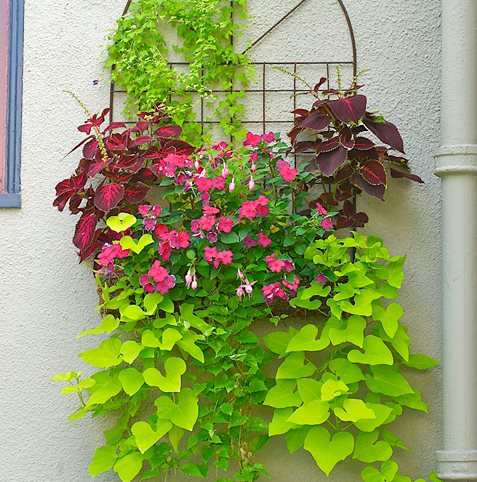Container Gardens Made for the Shade
We all seem to have that dark corner of our garden or porch that looks uninviting, cold, and in major need of color. Have no fear—Janet Loughrey offers solutions for livening up that shady area, including insights into the best plant combinations that will thrive in low light.Nearly every gardener has experienced the problem of too much shade, which can cause plants to become too leggy or fail to thrive. Whether it's a wooded suburban lot or a north-facing apartment balcony, low light means more growing challenges. Rather than being problematic, these dark areas can be viewed as an opportunity. (See more articles about shade gardens.)

- HELLEBORES - early bloomers; partial shade
- FERNS - try a Japanese painted fern, maidenhair or deer fern
- BEGONIAS - try ‘Bonfire’, Rex or tuberous begonias
- HOSTAS - try a minature variety such as 'Tiny Mice'
- JAPANESE MAPLES - a single specimen makes a strong statement
- BAMBOO - Phyllostachys nigra offers structure and height
Adding containers to shady spots is a practical way to optimize these spaces. By using brightly colored or shiny metal pots, combined with lighter or contrasting hues of foliage and flowers, these decorative arrangements can brighten up even the darkest corner of a porch, deck, or entryway.
Choosing the right plants is essential to successful shade gardening. Woodland natives, ferns, and hostas are just a few plants that prefer lower light levels. Many garden specimens will thrive equally well in containers, given the right conditions. A single plant, such as Japanese maple or bamboo, can be just as compelling as a combination.
Plants with attractive foliage offer reliable season-long color. Coleus are workhorses of the shade garden, with a nearly endless array of colors. Other reliable foliage standbys include Japanese painted fern, sweet potato vine, and Rex begonias.
An underutilized alternative to annual bedding impatiens is Torenia (wishbone flower), which blooms consistently over several months in colors of blue, purple, pink, and yellow. Other prolific bloomers include fuchsias and begonias such as ‘Bonfire’.
Optimal growing conditions are essential to healthy shade container plantings. Landscape designer Lucy Hardiman uses high-quality potting soil, replenishing it annually. She mixes a time-release fertilizer into the top several inches of soil before planting. Because containers need frequent watering during hot summer months, nutrients quickly leach out of the soil. In midsummer, Hardiman supplements with a water-soluble bloom booster fertilizer every other week.
There are no hard and fast rules to mixing and matching plants for shade containers. Breaking the rules can result in some unexpectedly delightful surprises.
RELATED:
Container Gardens






